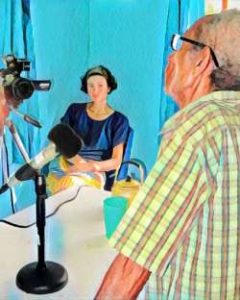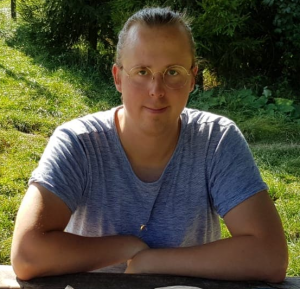Before kicking off another semester of blogging about language diversity, we thought it might finally be time to introduce ourselves properly. And what better way to do that than by our favourite language features? We asked our team members to tell us about an attested linguistic property that they wish their mother tongue had. So, without further ado, here are some of the people behind this blog along with their most-missed language features:

Eline Visser
Main research interests: Language documentation and description
A feature I wish my native language had: More case marking! It’s elegant and often shorter than using prepositions. I’d also wish for more case marking in all the languages I try to learn, because prepositions are a pain in the ass to get right.

Niklas Erben Johansson
Main research interests: My research primarily involves lexical iconicity, that is, the resemblance-based relation between sound and meaning, which I study from typological and experimental perspectives.
A feature I wish my native language had: Much in line with my own research, I would love if Swedish had a large set of ideophones. Ideophones (which are also referred to as expressives or mimetics) are words that evoke vivid impressions of sensory perceptions such as shapes, movements and colors. For example, Japanese doki-doki evokes the pounding of the heart and Siwu saaa evokes a cool sensation. Ideophones are common in some parts of the world, such as in Africa, Asia, and the Americas, where they constitute entire word classes on par with nouns, verbs and adjectives, but they are mostly absent in Eurasia with the notable exception of Basque. Having easy access to a large repertoire of expressive words seems like very fun way to spice up the often mundane act of speaking since it would change how stories are told and very efficiently convey complex thoughts, feelings and sensations.

Arthur Holmer
Main research interests: I am currently working on completing a reference grammar of the Austro-Asiatic language Kammu. Otherwise, my research interests deal primarily with the Formosan langauges (Austronesian languages of Taiwan), and more generally, I am interested in what keeps the clause together: word order, case relations, agreement etc.
A feature I wish my native language had: One feature which I really miss in Swedish (and English, and presumably all European languages) is wh-verbs, i.e. a verb meaning ‘to what?’. It seems such a handicap that, although we can question virtually any element in the clause (what?, who?, when?, why?, how?), we can not question the nature of the action itself. Instead we have to resort to clumsy methods of rephrasing the question, treating the action as the object of a dummy verb like “do”: What did you do _ ?, which is a a direct parallel to: What did you buy _ ?
In Swedish, given that the verb göra means both ‘do’ and ‘make’, a question targeting the verb even becomes ambiguous: Vad gjorde du _ ? (‘What did you do/make?’) This question could equally felicitously be answered by: a) Dansade. ‘Danced’; or b) Köttbullar. ‘Meatballs.’
This is a completely pointless gap. It is so much more elegant in the Formosan languages of Taiwan, as well as in many other Austronesian languages, where there is a dedicated verb which means ‘to what?’, which behaves like any other verb, and is inflected in the same way, cf. the following example from the Formosan language Seediq:
H<m-n>uwa=su ciga? <ACT-PRF>what?=you yesterday ‘What did you do yesterday?’ (lit. ‘Thou whattedest yesterday?’)
Not only would this fill a natural communicative gap, but as a syntactician, I can’t help being curious as to how wh-verbs would behave syntactically in a language like Swedish: would they be placed in 2nd position (like verbs) or would they be fronted (like wh-words)?

Alex Garcia
Main research interests: I am interested in how languages structure or categorize their meaning, and also in how they develop their grammar. I have worked mostly on a language belonging to the Austronesian family (Northern Alta, see picture above), and previously worked on a Niger-Congo language (Diola). Outside of academic research, the language I enjoy the most is Mandarin Chinese.
A feature I wish my native language had: I think it would be cool for Spanish to have a distinction between a second person plural exclusive pronoun meaning ‘us, but not you (the addressee/s)’, contrasting with the inclusive pronoun nosotros ‘us’. This feature is not attested in any Romance or Germanic language but is very common in other language families, as shown in this map: https://wals.info/feature/39A#2/18.0/149.6

Filip Larsson
Main research interests: My research topic is affixation in the languages of the Caucasus and my main fields of interest are historical linguistics, morphology, language contact and lexicology (particularly food terms).
A feature I wish my native language had: One thing I really miss in my native language Swedish is the absence of evidentiality marking, i.e. the possibility to use different verb forms to indicate if I have witnessed something myself or if I heard it by hearsay. Some languages even have an explicit dubitative to express doubt as well, which can be useful when you are talking about something that you have not experienced yourself and you doubt the validity of. If English had both explicit evidentiality marking and a dubitative form the sentence “I’ve heard that cats secretly rule the world but I really doubt it” would then become e.g. “cats rule-HEARSAY (1SG)-DOUBT the world”.
Victor Bogren Svensson
Main research interests: morphosyntax, linguistic diversity, Austronesian languages, Eskimo-Aleut languages, Sino-Tibetan languages
A feature I wish my native language had: I wish my native language had noun incorporation! The ability to integrate nouns (and other word classes as well, if allowed to broaden the scope!) into verbs to form finite verbs with the complexity of entire sentences is a feature that I find fascinating!

Sandra Cronhamn
Main research interests: I currently work on the classifier system of the Arawak language Baniwa, spoken in northwestern Amazonia. In more general terms, I’m interested in the semantics encoded by grammatical systems, as well as in how languages change over time and how they are affected by being in contact with one another.
A feature I wish my native language had: An elaborate, shape-based nominal classification system! Sure, Swedish has a two-partite gender system, but how cool wouldn’t it be if we attached classifiers to e.g. our numerals to specify if we are talking about the fruit, leaves or tree of a certain plant species? Swedish generally solves this problem quite well, I have to admit, by compounding (the gender inflection on the numeral is not relevant here), but I have a soft spot for the Baniwa way: changing the ending of the numeral (apa- in this case, meaning ‘one’) and leaving the noun intact. Baniwa has around 50 classifiers of this kind, which fill lots of different functions in a really elegant way.
Baniwa Swedish apáda manákhe 'a single açaí fruit' en banan 'a single banana fruit' aphéko manákhe 'an açaí tree' ett bananträd 'a banana tree' apáphe manákhe 'an açaí leaf' ett bananblad 'a banana leaf' apeétsia manákhe 'a bunch of açaí' en bananklase 'a bunch of bananas'
